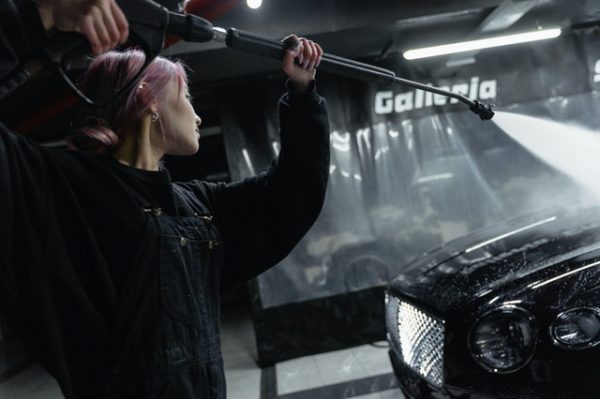Last updated on January 30, 2023
The lights on your vehicle let other drivers on the road know what you are doing, and of all the lights on your vehicle, the reversing lights are some of the most important. But what do you do when your reverse lights aren’t working the way they should?
What are some of the common causes of this serious problem, and more importantly, how do you fix it? We’ll walk you through everything about how the system works and give you some troubleshooting tips so you can figure out what’s going on and get back up and running properly.
Do you need help with a car problem RIGHT NOW?
Click here to chat online with a verified mechanic who will answer your questions.
Related: 6 Reasons Your Taillights Don’t Work (But Your Brake Lights Do)
How do reversing lights work?
If you want to fix a problem, you need to know how it’s supposed to work. With reverse lights, it’s a pretty straightforward process that we’ll walk you through here.
You start by putting the vehicle in reverse. Whether the vehicle has an automatic or manual transmission, this shifts the gear selector on the gearbox to the correct gear. As it turns, the reverse light switch turns with it. When you go into reverse, everything lines up to complete the circuit.
Power goes through a fuse or relay, and the reverse lights come on. When you back the vehicle up, the switch opens, cutting power to the system and turning off the lights.
Reasons why your reversing lights don’t work
If you can’t get your reverse lights to come on, it’s a serious problem. But to solve it, you need to know what could be causing it. We get it, and that’s why we’re highlighting five of the most likely reasons why your reverse lights aren’t working properly for you here.
1 – Burnt out bulb
While this is likely not the problem if none of the backup lights work, it could be the problem if you just replaced all of the bulbs, or if only one or two of the backup lights aren’t working.
The good news is that this is one of the easiest problems to fix and it doesn’t cost a lot or require a lot of work to see if this is the problem.
2 – Fuse/relay blown
If your reverse lights worked fine one day and cut out completely the next, there may be a blown fuse or bad relay somewhere in the circuit. It’s a fairly common problem, but it’s one that many people overlook.
Before you jump into more complicated problems, rule out the simple stuff, and few things are as simple as a blown fuse or relay. Power must pass through these components for the reverse lights to work.
3 – Faulty reverse light switch
When you put your vehicle in reverse, the lights don’t magically come on. The reverse light switch completes the circuit and sends power to all the lights in the rear of your vehicle. It’s a pretty simple design, but it’s also extremely effective.
But if the switch ever fails, you won’t be able to complete the circuit to turn on the lights. They can fail in many ways and when they do you won’t be able to turn on your reverse lights.
4 – Wiring problems
For your reverse lights to work, electricity must reach the bulbs, and the wires carry power from point A to point B. Wiring problems range from crossed lines to breaks, and wiring problems can present themselves in many ways. different.
They can short out various components, destroy light bulbs, or simply prevent power from reaching its intended destination. Unfortunately, wiring problems are notorious for being difficult to trace.
Also Read: 3 Signs of a Bad Turn Signal Relay
5 – Defective gear selector
If you can’t back your vehicle up, the problem probably has nothing to do with your lights. The gear selector allows you to control this part of your vehicle and if it is not working properly you may not be able to reverse at all.
When this happens, it’s a whole different troubleshooting process, but something to rule out when attempting to repair your reverse lights.
How to Troubleshoot and Troubleshoot
Just knowing what the problem might be won’t help you figure out exactly what it is. To do so, you need to do some troubleshooting, starting with paying attention to everything that’s going on.
Don’t all the reverse lights work or just one or two? If none of the reverse lights work, start by pulling a single bulb. Look to see if the filament is still intact. If not, replace it and see what happens.
If the new bulb fails, there is a short in the system that you will need to find. But if it works, you may need to replace all the bulbs.
If the bulbs fail, move on to the fuse and relay. Just swap the fuse or relay with one you know works and see if the problem migrates. If it does, that’s the problem!
After that, it’s time to move on to the reverse light switch. You will need to access the switch while still in your vehicle to test it. Use a test light and put the vehicle in reverse. Check each terminal and see if there is power there. At this point, there should be power at each terminal.
Then put the vehicle in another gear. When you do, there should only be power on one side of the terminal. If the switch doesn’t work this way, it may need to be replaced.
Finally, it could be a wiring problem with your vehicle. Unfortunately, wiring problems can present themselves in many different ways, making troubleshooting difficult. Usually you’ll need to find out if everything is connected the right way and then check for power along the line until you find a break or deviation.
Where is the reverse light switch located?
If you are looking for your reverse light switch somewhere in the cabin of your vehicle, you are sorely mistaken. That’s because the reverse light switch is under your vehicle next to the transmission.
More specifically, it is in the gearbox, which turns the switch to connect the terminals. When this happens, it completes the circuit and turns on the reverse lights.
Are reversing lights required by law?
Yeah! Although much older automobiles didn’t always come with reversing lights, if you want to drive a vehicle on the highway these days, you need at least one reversing light. The vehicle not only needs a reversing light, but it must also be operational.
If you’re looking to install an aftermarket reverse light on your vehicle, it’s usually not too difficult and the switch will end up somewhere on the dash.
Reversing lights are an important safety feature on your vehicle and if you plan to drive it on the highway, it is a must have feature.
What happens if the reverse lights stay on ALL the time?
If your vehicle’s backup lights stay on all the time, it’s really no different than having no backup lights at all. Interestingly, many of the issues that cause your reverse lights not to stay on can also keep them on all the time. It’s similar to when you can’t get your brake lights to go off.
Wiring problems can send power to the bulbs all the time, and a faulty reverse light switch may not be able to shut off power when you take the vehicle out of reverse.
In short, if your reverse lights stay on all the time, follow the same troubleshooting steps as if they didn’t and you should be able to figure out what’s going on and fix the problem.
With degrees in both Automotive Technology and Journalism and Mass Communication, Adam brings a unique blend of experience and passion to every article he writes.




